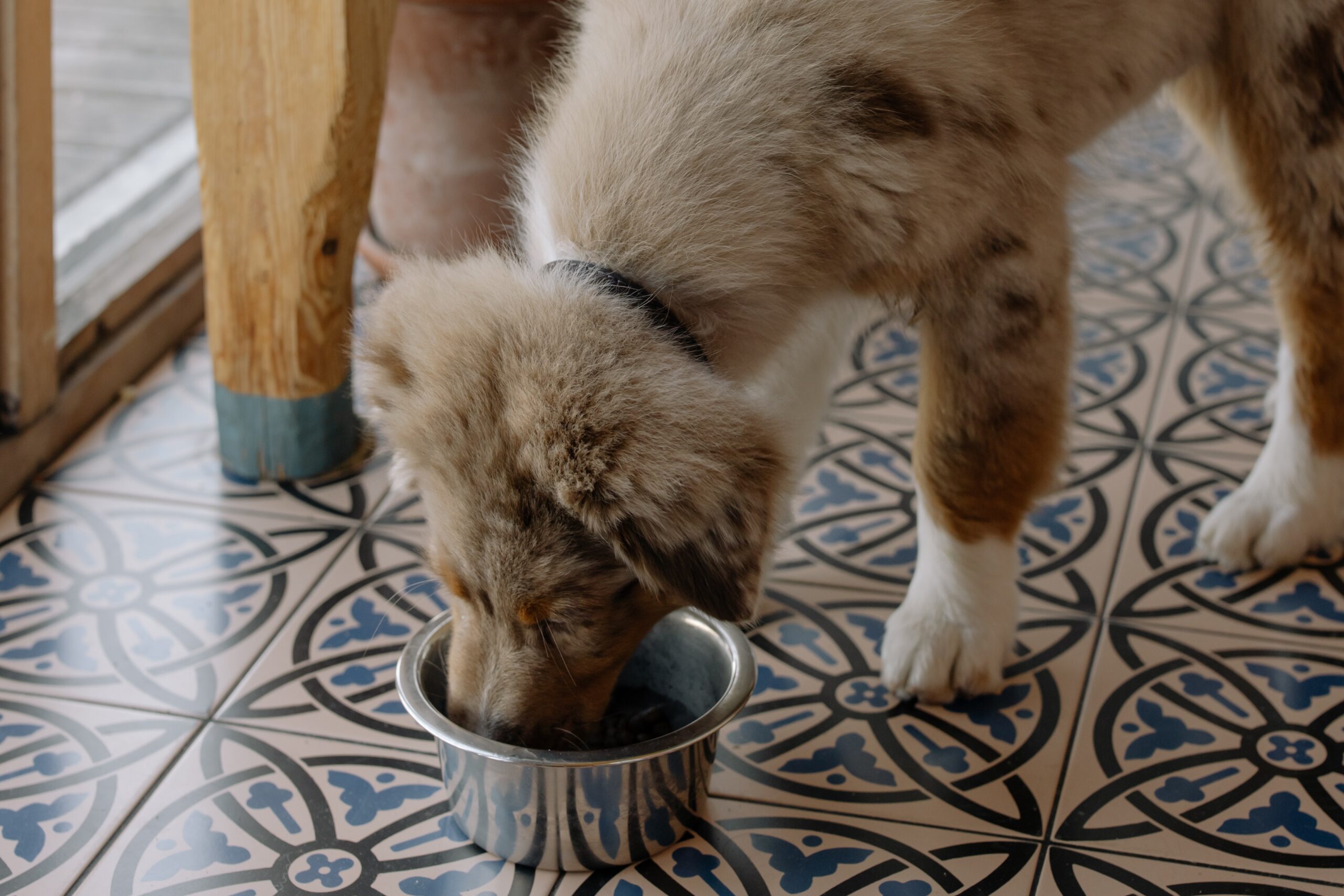Why is there animal fat in my pet’s diet?
by Ontario SPCA and Humane Society | Interesting | July 5, 2022

Guest blog by Dr. Juanita Glencross, Royal Canin
It seems like lately I have been getting more questions about why a particular ingredient may be in a pet diet. This is particularly in relation to diets prescribed to a patient with either a suspected or proven food allergy, and I often get the question when the diet has an animal source of fat listed in the ingredient deck. Sadly, the ingredient list on a bag of pet food can lead to a lot of confusion for pet parents, especially those who are reading the ingredient list because they want to do the very best for their pet.
The first thing that you need to know is that your pet is allergic to specific nutrients and not ingredients. What this means is food allergic pets are allergic to specific nutrients (in the case of food allergies this nutrient is protein) and not to specific ingredients, for example, chicken. If your pet is allergic to “chicken,” then they are allergic to chicken protein and not every part of the chicken because chickens are made up of many nutrients including protein, fat, water, minerals, and vitamins. As a result, a chicken allergic dog, while allergic to chicken protein, is not allergic to fat, water, minerals, or vitamins, which can also be sourced from chickens.
As an aside, this is also the time when I occasionally need to remind pet parents that fat is a good thing and that we should embrace it. Fats bring lots of good things to your pet. Fat is extremely palatable and is an excellent source of energy. After all, food is fuel for the body and animal fats are highly digestible by cats and dogs. They can use approximately 95% of the energy contained in fat.
Fat also contains much higher calorie levels than they can get from a protein or carbohydrate energy source. One gram of fat provides about nine calories of metabolizable energy to the pet, which is about 2.5 times more than a single gram of protein or carbohydrate. Additionally, these fats are an excellent source of essential fatty acids which, as the name implies, cannot be made by the body in adequate amounts and therefore need to be provided in the diet. Some of the more commonly recognized essential fatty acids provided by fat are omega 3 and 6 fatty acids. For example, some Omega 3 fatty acids, such as DHA, have anti-inflammatory properties and play an important role in skin health and brain development. In short, fats are good, and yummy, for your pet when fed in appropriate amounts.
Now, back to the other reason that people with allergic pets tend to be fat phobic. Understandably, these pet parents try very hard to avoid the PROTEIN to which their pet is allergic and so the ingredient list seems like a good place to start. Sadly, this is not always the case. When an ingredient deck lists the source of the fat (for instance chicken), then many pet owners assume that their pet will be allergic to the food because there is a nutrient in it (fat) which comes from an animal whose PROTEIN their pet cannot tolerate. This concern can be valid; however, it is very important at this point to discuss the quality of the diet recommended.
The decision about which diet to recommend always comes down to validated and proven quality control measures during the manufacturing process. The World Small Animal Veterinary Association has a fantastic handout about selecting pet foods. For your veterinarian, the pet food chosen for an allergic pet (which by definition is an animal with a medical condition) will be one which they are confident will not contain undeclared or unexpected protein and it will most likely be one where they know that the manufacturer has validated and monitored the diet for these unexpected proteins.
One way to be confident in the quality of the raw materials is to think about how the ingredient is processed into its nutrient components prior to being added into a diet as a raw material. Now, the word “processed” is often vilified because people generally associate it with junk food processed for convenience or shelf life, this is not the case here. We are talking about processing for quality and purity. Using our chicken example, the chicken fat used in some prescription diets is not “raw fat,” which could contain ancillary proteins. The fat goes through several decantation and filtration steps, and it has antioxidants added to prevent the purified fat from going rancid. After the purification process, we are left with pure fat, a little bit of water, and a few fat-soluble vitamins.
For example, at Royal Canin, there are some key practices in place to ensure that there is no unexpected protein in our diets, which is particularly important in diets intended for food allergic pets. Prior to selecting a Royal Canin supplier, validation checks are done to ensure that they can consistently supply the ingredient at the level of quality expected and every supplier gets re-evaluated on a regular basis. When choosing suppliers and ingredients, we also take the environment into account – it is our responsibility to find sustainable ways to feed our pets and, today, this is more important than ever.
Samples are taken from every raw material supply truck that arrives at our manufacturing plants, using a special sampling rod designed to get material from all levels of the trailer, including deep down in the truck bed where things like fungus may be hiding. If these samples fail the testing, that truck and everything on it gets turned away and those raw materials do not get used. This happens very rarely due to the extensive supplier validation process and all the on-going quality efforts of our suppliers. For some diets recommended for allergic patients, we also test each production run for protein contamination using quantitative DNA testing (for protein) and all manufactured products are held and are not shipped to the market until the test results are finalized. Your veterinarian will work with companies they trust so that they can feel confident recommending their diets to a pet with food allergies.
At the end of the day, we both – me the veterinarian and you the pet parent – want the same thing for your pet’s food. We want it to be safe, nutritious, and we want it to be right for your pet. This is especially important if you have a pet who has a food allergy or intolerance, but we must remember that while ingredient lists can be helpful, they do not detail the nutritional quality, digestibility, or the bioavailability of the nutrients that are derived from ingredients.
While the list may help with choosing a protein source that your pet can tolerate, we need to remember that what is most important is the quality of the manufacturing process, and for diets which are intended to be fed to allergic pets, the final quality testing of the diet to ensure that there is no extraneous protein which might incite an allergic response in your pet. This would be similar to a “peanut-free” snack we would use for a child with a peanut allergy, as compared to a snack which lists “may contain peanuts”. Even though there may be no peanut products in the snack, other peanut containing snacks may be made in the same facility and they may not have verified that there are no peanut allergens in the final product. With certified “peanut-free” snacks, it has been validated by the manufacturer that there will be no peanut in the product.
Let’s work to no longer be ingredient phobic, but rather nutrient and quality focused. So, bring on the validated, protein-free, purified fat which provides many health benefits to your pet and let him or her enjoy highly flavourful and nutritious food.

Dr. Juanita Glencross, DVM, currently works as a Scientific Communications Veterinarian with Royal Canin Canada. A career-long educator, she relishes teaching both the home-dwelling humans who are owned by dogs and cats, as well as the veterinary professionals that keep the animal masters healthy. Much like the cat that came back, after several years in private, small animal practice she returned to her alma mater, the Atlantic Veterinary College as a clinical faculty member. In 2010, Juanita transitioned to teaching in Industry. She now shares healthful, practical, and accessible pet nutrition recommendations with all who serve the pet masters. Juanita is currently owned by an imperious mini, wirehaired Dachshund as well as an alien overlord that masquerades as a cat.
Categories
Testimonial
For every animal you save
For every animal you save, every animal who feels loved in their last moments, and for everything else you do; thank you and God Bless.
